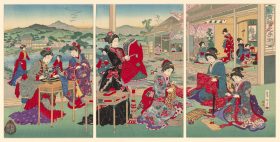Former ArtsReady trainee Monica McDonald. Image: supplied.
Despite their rich and diverse culture, First Nations people remain underrepresented in the Australian arts industry.
As the recent Showcasing Creativity research from the Australia Council reveals, only 2% of the 6000 works programmed in the 2015 season by 135 Australian presenters were Indigenous. Troublingly, two thirds of these presenters didn’t present any work by Aboriginal of Torres Strait Islander artists in 2015 – meaning only a few companies are actually staging First Nations works.
Many factors contribute to these dismal numbers, from concerns about financial risk to ignorance about what is available and a fear of doing First Nations’ work ‘wrong’.
But it is clear that change will require initiatives in two directions: developing skills and opportunities for Aboriginal and Torres Strait Islander artists and arts workers to break into mainstream venues, and building arts centres’ confidence when it comes to programming First Nations work.
For arts organisations that want to provide more practical support for First Nations people, ArtsReady’s national traineeship program is a good place to start.
Warumilang, the ArtsReady Aboriginal and Torres Strait Islander program, includes a traineeship that provides sustainable employment pathways for young Indigenous people. On the other side of the equation, ArtsReady offers cultural awareness training for organisations that want to develop a deeper understanding of Aboriginal and Torres Strait Islander people and culture.
Developing skills and opportunities
To ensure a growing pool of well-qualified Indigenous artists take advantage of these opportunities, Warumilang advocates for young Indigenous people through its highly successful traineeship. The traineeship combines on-the-job training with a vocational qualification that can lead to further studies or employment in the arts.
‘We obviously work within those entry level areas. That’s our expertise. Like the [Showcasing Creativity] report said, there is a lack of young Indigenous people coming through those areas. ArtsReady can support that, we can complement that and build these young people up through entry level positions,’ said Andrew Craig, ArtsReady State Manager, New South Wales.
‘A lot of people are passionate about the arts and creative industries but not everyone is suited for university. So how do we capture those people and make sure they are going into an industry they are excited about, where they can grow and flourish and excel?’

Andrew Craig, ArtsReady State Manager, New South Wales. Image: supplied.
Creating a platform for future Indigenous leaders
Former ArtsReady trainee Monica McDonald told First Nations Telegraph her traineeship ‘threw me head first into the industry and allowed me to flourish as an artist.’
‘I completed an ArtsReady traineeship in 2015 with Indigenous theatre company Ilbijerri. My time there contributed to the life experience I needed to be accepted into the Victoria College of the Arts this time round.’
‘I was exposed to it all, from marketing, administration to performing on stage and everything in between. I also had the chance to meet actors, playwrights and directors and formed relationships internally and externally through Ilbijerri which has helped me in the industry,’ she said.
Andrew Craig explained that organisations often understand the growing need for these sorts of pathways, but they don’t necessarily know how to do it. But by working with ArtsReady traineeships this pressure is taken off.
‘Everything from administration to payroll, to mentorship and ongoing support all comes with the program. What the organisations have to do, and what our host employers have to do, is provide trainees with day-to-day training supervision and the skill sets they need, while ArtsReady does all the back-end of stuff.’
More information about host responsibilities for the ArtsReady Traineeship program here
Building the confidence to program First Nations work
As arts organisations become more culturally informed, they will understandably become more aware of Indigenous stories and programming that could be brought to the stage. ‘It’s all about building those pathways, so starting off at a stage where organisations are becoming culturally aware and us providing the platform to support them,’ said Craig.
‘Organisations are starting to understand the importance of [cultural awareness]. The feedback on the program from our partners has been exceptionally positive. It’s just going from strength to strength.’
In 2015 alone, more than 700 people participated in these training sessions, including major institutions such as the National Gallery of Victoria and Arts Centre Melbourne.
One extension of cultural awareness proficiency is for arts organisations to develop their own Reconciliation Action Plan (RAP). A RAP enables organisations to commit to practical actions that build respectful relationships and create opportunities for Aboriginal and Torres Strait Islander people. It’s up to organisations to choose their level of commitment. Warumilang can guide organisations through their RAP, which might include a commitment to more Indigenous programming or perhaps providing a traineeship in production or administration.
Find out more about ArtsReady’s Cultural Awareness Training
Since Showcasing Creativity was published on August 31, many performing arts organisations have reflected on their own record of programming. Some feel they can do better to offer Indigenous stories on stage. ‘Organisations may be asking, how can we do this?’ observed Andrew Craig. ‘How can we help these young Indigenous people? The answer is pretty clear – it’s a program like ours.’
To find out more about Warumilang visit http://www.artsready.com.au/indigenous, or contact: Andrew Murray, General Manager ArtsReady via email: Andrew.Murray@artsready.com.au.





